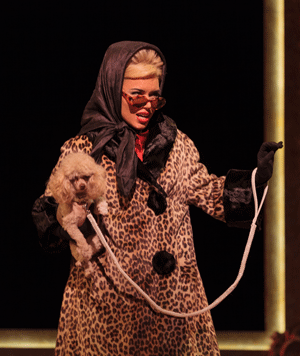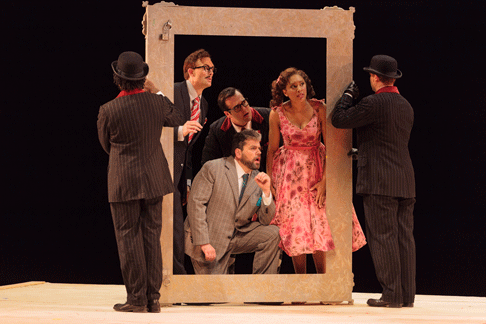23 Jul 2013
Glimmerglass’s rarely done ‘King for a Day’ a rare treat, well done
This zany production of Verdi’s only comic opera before ‘Falstaff’ keeps the singers in chaos and the audience in stitches

This zany production of Verdi’s only comic opera before ‘Falstaff’ keeps the singers in chaos and the audience in stitches
The heroes of the Glimmerglass production of Verdi’s rare — really rare — second opera, Un Giorno di Regno (King for a Day), are director Christian Rath, choreographer Eric Sean Fogel, and set and costume designer Court Watson. This trio has taken a work with a threadbare, unfunny plot, and only intermittingly inspired music, and transformed it into an afternoon of zaniness that delighted the audience in the Alice Busch Opera Theater in Cooperstown.
Verdi wrote this work in 1840 when he was 27. It is his only comic opera until Falstaff, the final masterwork of his old age. Un Giorno was booed by the audience in Milan, in part because of poor singing, and it received but a single performance.
Verdi bounced back from this disappointment with his third opera, Nabucco, which is about as far in spirit from Un Giorno as one could get. He was clearly not looking in the rear-view mirror. Just as he abandoned the comic path, so has the work been abandoned by opera houses in the last 173 years, although Europe has seen a few mountings.
The Rath team put the six principal singers and the chorus through all sorts of physical activity — climbing, jumping, boxing, kissing, dancing, and swinging chairs at each other in a chaotic closing scene to Act 1 that is reminiscent of The Barber of Seville and The Italian Girl in Algiers, both by Rossini, whose presence hovers over Verdi in this creation. The site gags come so thick and fast and are so ingenious that the audience forgets this soufflé could collapse at any minute if the temperature is not kept at a high heat.
 Ginger Costa-Jackson as Marchesa
Ginger Costa-Jackson as Marchesa
Rath signaled to the audience that a circus was about to start by projecting clown-costume circles of color on a white curtain during the toe-tapping overture. Then, in the English titling (for a production sung in English), the audience was invited to attend a double wedding and to allow four hours “to clear security.” Similar 21st century touches were interpolated in the text by Kelley Rourke, who did all she could to make this creaky story of young love thwarted (and then triumphant) relevant.
The stage business was so intricate, and non-stop, it was a wonder that the first performance went so smoothly. I expected the cast to fall off the steeply raked set at any moment and tumble into the orchestra pit, but no one did. Indeed, if anyone was ever out of place it wasn’t evident to the audience. The physical comedy delivered by the young cast assured a success.
Had Verdi not been the one to write this, however, no one would stage it today. So, is the great master present at all in the music? Here and there, yes. A few phrases from mezzo-soprano Ginger Costa-Jackson (as the Marchesa) find their way into Gilda’s music in Act 1 of Rigoletto. Some of the choral work prefigures Ernani.
What is more instructive, however, is how Verdi assimilated Rossini, Donizetti and Bellini in this work, which is only to be expected given how wet behind the ears he was. The basso buffo singing of Doctor Dulcamara (The Elixir of Love) and Don Pasqualeare not far from the surface in the music for bass Jason Hardy as the Baron Kelbar, and baritones Andrew Wilkowske (as La Rocca) and Young Artist Alex Lawrence as the King of the title. One extended passage for the King and chorus in Act 1 is a close parallel to music from Rossini’s Il Viaggio a Reims. A promising duet for tenor and baritone in Act 1 could be plopped into Bellini’s I Puritani without much alteration.
And so it goes for about two hours of music — little Verdi, but lots of early 19th century Italian opera by other masters. What he did demonstrate at 27 was his ability to write for the voice. The tenor part (the love-sick Edoardo, sung by Young Artist Patrick O’Halloran) is particularly fine.
As the Marchesa, Costa-Jackson was the only “name” singer in the cast. Dolled up in a red sheath and a blond beehive wig, she vamped around the stage, often holding a twinkly gray toy poodle that adamantly refused to move at one point in the first act. Her part lies high for a mezzo, and Costa-Jackson had some problems at the top of the range. But given she was in a track meet of a production that must have sorely taxed her lung power, it’s surprising she sang as well as she did.
 Clockwise from top: Jason Hardy as Baron Kelbar, Patrick O'Halloran as Edoardo, Jacqueline Echols as Giulietta and Andrew Wilkowske as La Rocca
Clockwise from top: Jason Hardy as Baron Kelbar, Patrick O'Halloran as Edoardo, Jacqueline Echols as Giulietta and Andrew Wilkowske as La Rocca
None of the three low-lying males — Hardy, Lawrence, and Wilkowske — has the cavernous bass or baritone voice, or the agility in articulation, to do justice to the patter. Nor do they have the blustering style of a Doctor Bartolo. All were too light for their roles, but they threw themselves into the proceedings with gusto, particularly Hardy. His impersonation of a boxer alone is worth the price of admission.
The best singing came from the young couple (who would become Nannetta and Fenton in Falstaff in another 53 years). Young Artist Jacqueline Echols was a prim Giuletta in her modest patterned dress. She has a melting soprano voice and terrific stage presence, even when singing from under the raked stage. As her true love Edoardo, O’Halloran looked like Clark Kent in an argyle sweater, matching socks, shorts and black-frame glasses. He doesn’t yet sing like Superman, but he has much potential. His voice seems agile enough for Rossini, but also with sufficient heft for Donizetti and Bellini. For me he was the most rewarding singer on stage.
The two smaller parts of Delmonte and Count Ivrea (who totters around on a walker) were assumed by two more Young Artists, Andrew Penning and Joe Shadday.
The performance was conducted by Joseph Colaneri, the new music director of the Festival. He miraculously led a crisp, tidy performance in which everyone stayed together even as they were rocketing around the stage. I don’t know how this was achieved, but it was. The orchestra played very well for its new boss.
Un Giorno can be heard on CD in a luxury cast that includes José Carreras, Jessye Norman, Fiorenza Cossotto and Ingvar Wixell on Decca, under conductor Lamberto Gardelli. The score holds up in repeated listening, particularly with the manic images from Glimmerglass in one’s head. Even though Rath’s production book must be 5,000 pages long, other companies might want to take a look at this rarity — if the cast is young and fit.
David Rubin
This review first appeared at CNY Café Momus. It is reprinted with the permission of the author.